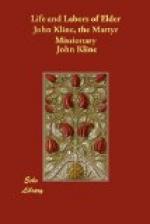INTRODUCTION.
In the burying ground of the Linville’s Creek German Baptist church in Rockingham County, Virginia, there is to be seen a marble slab engraved with the name John Kline.
In walking through a cemetery and pensively viewing the memorials of the departed, one question of deep interest often presses upon the mind and heart: Are these, whose names are here recorded on slab and obelisk, still alive and in the possession of conscious being, or are they dead—
“All to mouldering darkness gone;
All of conscious life bereft?”
We turn to earth, and from her lips the ear of reason catches deep-toned words of assurance that death is not the end of life. The hue of the butterfly’s wing, “the flower of the grass,” the beauty of the vernal year, these all, all teach the sublime truth that “all great endings are but great beginnings.” The voice of God from the unrolled page of plainer if not diviner truth, says: “These are not dead, but sleeping—they shall wake again.”
Satisfied on this point, the next question turns to the lives and characters, works and words of those who lie buried here. Were they good or bad? Are their spirits now in heaven, or somewhere else? There are two classes, however, concerning whom no such questions arise. The first class is made up of those who have died in their infancy; and ever and anon while looking at the “little lamb,” or “rose bud,” or “young dove” not yet fledged, the words flow into the mind as from the lips of Jesus: “Of such is the kingdom of heaven.” The other class is composed of such as have given clear evidence, by profession and life, that they are the children of God. The words for them come as did the others, from the page of Heavenly Truth, “Therefore are they continually before the throne, and praise him day and night in his temple.”
The epitaph of John Kline is read without a doubt ever springing up in the mind of any one who knew him. We saw him, not as Elisha saw Elijah in sight, ascend to heaven; but with the eye of faith we saw him clothed in a celestial body; and with the ear of faith we heard the welcome: “Enter thou into the joy of thy Lord.”
THE ANNUAL MEETING OF 1878.
In the year 1878 the Brethren’s Annual Meeting was held with the Linville’s Creek church. Brethren and sisters from many sections of our Union were present. Many graves in the cemetery by the meetinghouse were to be seen. Epitaphs were read by the throngs of people who walked around to view them. Few of these bore anything beyond the simple inscription of the name and the two facts that fall to the lot of all: The time of birth and the time of death.
But there was one grave from whose humble mound each visitor seemed eager to pluck a flower, a leaf, or any other little thing that might be carried back home and enshrined in a casket for a memento of one never to be forgotten. That grave was the grave of John Kline.




